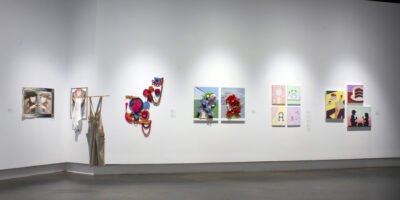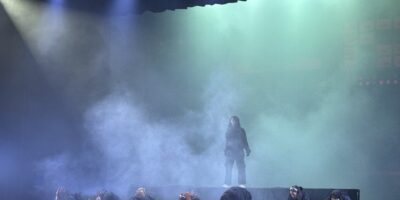Sometimes, a director gets ambitious. It’s not just enough to make a good film with one storyline, one time period, and one setting, oh no. One must expand the perceived scope of the movie by introducing a romance that spans lifetimes, the idea that all souls are connected, or applying cosmic scale to a run-of-the-mill universal human truth.
This is not necessarily a bad thing. Introducing cosmic scale requires funding. Funding gets hype. Hype gets decent actors. Decent actors do their very best to make the script seem believable. The end product is also likely to cultivate a fleeting impression of awe and wonder as the viewer comes briefly to terms with their smallness in the universe.
These plot-bloated movies also tend to have high production quality and attractive sets, even if the script sucks. Thus they are worth a watch for the spectacle value alone, and by spectacle I mean “can director XYZ really pull off six stories in five countries spanning four hundred years nonlinearly?”
So here are five movies where the director got temporally or spatially ambitious, in the order that I watched them.
The Red Violin (1999)
A legendary violin with a crimson glaze is passed down through history.
Despite the logistical complexity of its multinational, multilingual production (Italy, Austria, England, China, and Montreal!), The Red Violin feels – dare I say – classical. Or, if you like, conventional. Each story segment is self-contained and chronologically after its preceding tale. The production is straightforward. There is no mystical imagery or particularly dizzying special effects. Which is fine. The Red Violin doesn’t have any pretensions of a grand, overarching destiny. The characters are connected only by the titular violin, which is the catalyst for the defining moments in their lives.
Though it’s not as flashy as other movies featured on Take Five this week, The Red Violin is a solid entry that occasionally aspires to greater things. Take, for example, the final reveal, which ties up the whole movie in a big red bow. Oh, baby.
Cloud Atlas (2012)
A young lawyer is ill on a ship in 1848. A composer works against time to finish his masterpiece in 1936. A reporter uncovers a scandal about a nuclear plant in 1973. A publisher is locked in a nursing home in present day. A genetically-engineered clone incites a rebellion in 2144. And in the distant future, a hunter tries to find a home.
This movie is, as one might say, a hot mess. The production and sets are lush and vivid. The actors play multiple roles, sometimes under heavy makeup, in different time periods, which are presented nonlinearly. Some plots – such as the Neo Seoul storyline – are more compelling than others. And try not to knock yourself out deciding whether or not it’s Hugo Weaving under the yellowface or Halle Berry in whiteface.
But do you have to fully understand something to be moved by it? I would say no. Cloud Atlas is a fairy tale. Fairy tales are universal. You move from the beginning to the end and eventually triumph, in one way or another. And instead of one fairy tale, Cloud Atlas gives you six. They all resolve beautifully at the end. It’s glorious.
The Tree of Life (2011)
Jack O’Brien (Sean Penn) reminisces about his childhood and his relationship with his parents: the authoritarian Mr. O’Brien (Brad Pitt) and the gentle Mrs O’Brien (Jessica Chastain).
The Tree of Life is has inventive and beautiful imagery, and the sequences depicting Jack’s childhood in Texas are effective and intense. Certainly, Terrence Malick succeeds at his goal of filming a cosmic meditation on love and grace and human nature.
Do you recall the scene in American Beauty where two teenagers watch a video of a plastic bag tossing in the wind and one declares it the most beautiful thing he’s ever filmed, while the viewers glance at their watches and mouth to each other “It’s still a plastic bag”? That’s how I felt, except instead of a two-minute sequence, Tree of Life is two hours long and lacks any sense of urgency.
However successful Malick was in realizing his vision, The Tree of Life is an overwrought, under-edited, pretentious monster of a film. My mouth gaped open but probably not for the reason he had in mind. At least an hour of the film features wobbly, light-infused cosmic landscapes with whispery voices praying in the background. Sean Penn walks around in the desert, looking lost, with about ten minutes of screen time, even though he has second billing. Jessica Chastain floats under a tree in the yard of the family home. A teenage boy pilfers lingerie from an empty house, but instead of doing what teenage boys do, he looks at the sunlight filter through it and then floats it down the river. At the end, there is a fifteen minute beach scene, with all sorts of people walking around, much as you’d imagine the afterlife, except that some characters were definitely still alive. I had the sense that I was watching something terribly profound, yet when I understood, it remained utterly meaningless and unrewarding.
If you must watch The Tree of Life, use a big screen and an open mind. Hallucinogens are optional but recommended.
Babel (2006)
A Japanese hunter gifts his gun to a Moroccan guide, who sells it to a goatherd. The goatherd’s young sons go out and test the gun, but hit an American tourist in a tour bus as it rounds a bend in the middle of nowhere. The tourist’s children are meanwhile taken with their live-in nanny to her son’s wedding in Mexico, because she cannot get a babysitter in time. There are language barriers everywhere. Bad things happen to everyone.
This is Lost in Translation if Bill Murray and Scarlett Johanssen were dirt-poor drug addicts on the lam. Babel is a grueling, Kafkaesque journey through ugliness and pain, where the grime stains your skin and the grit works into your boots.
Unlike, oh, Requiem for a Dream or Grave of the Fireflies, one never loses hope, and even dares feel optimistic about the fate of each character at the film’s end. Which is the perfect amount of hope, really, otherwise the hope would full-out blossom into joy and exultation. But nah. I admire director Alejandro González Iñárritu’s restraint in not giving everybody a happy ending. In real life, you can’t resolve lifetimes of cultural or linguist alienation in two hours either.
The Fountain (2006)
Hugh Jackman is a neuroscientist in modern-day America, a conquistador in 1500s Spain, and a cosmonaut in a bubble in the very distant future. He works against time to save his lover, who is dying (Rachel Weisz).
This is the movie that I would have liked Tree of Life to be. The Fountain is baffling at times (Is this real life? Are they reincarnated, or literally the same person? Is the astronaut reaching through time and space?) but every story is grounded in and thoroughly intertwined with every other storyline. The imagery is consistent. Hugh Jackman’s struggle to accept his lover’s impending death is a sympathetic motivation that brought tears to my eyes. The conclusion is not neat (Is this an alternate timeline? Was this whole movie a figment of his imagination?) but it does provide emotional closure. And as a bonus? Darron Aronofsky pulls it all off in 96 minutes.




Leave a Reply